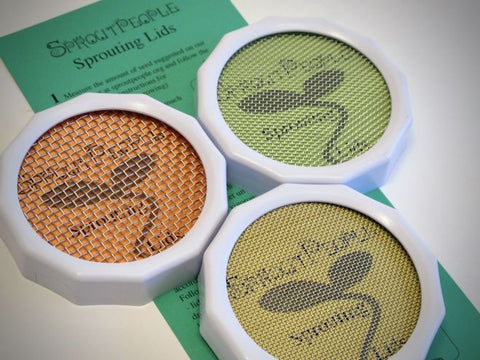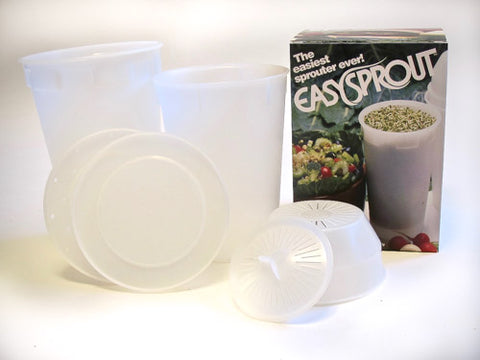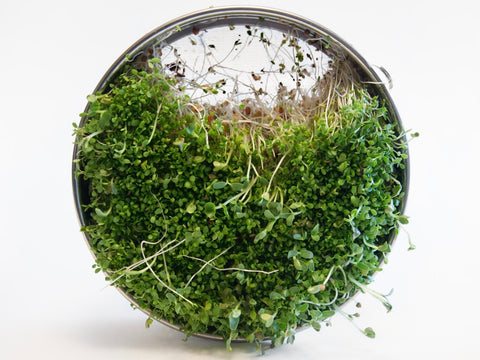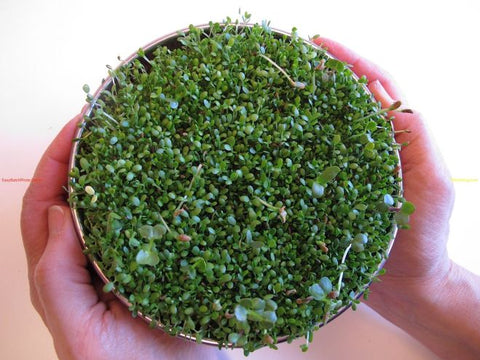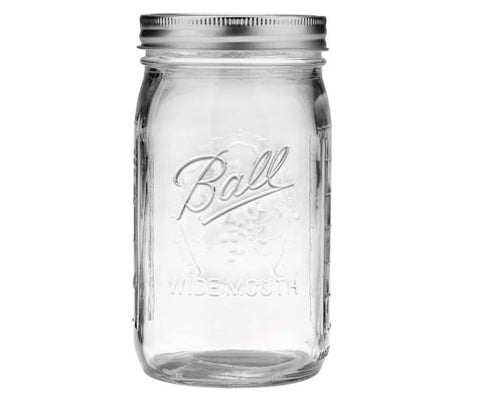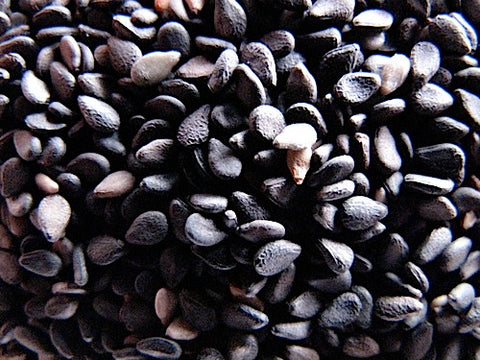
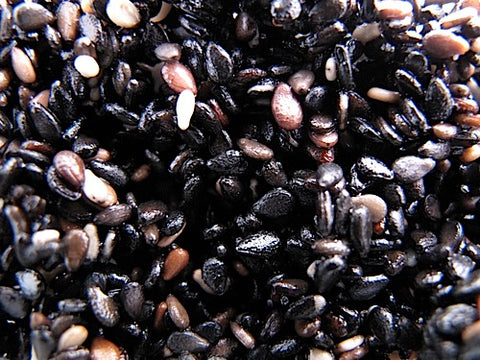
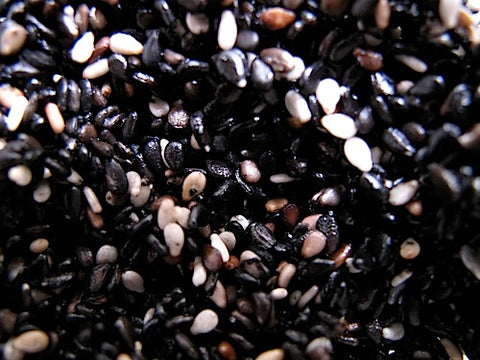
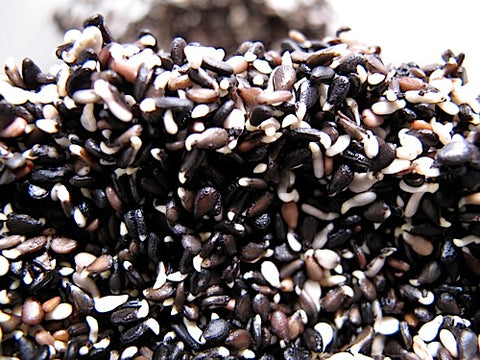
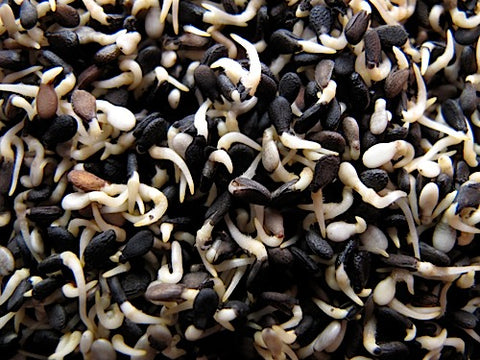
Black Sesame Sprouts
A small, nutty sprout which makes a great addition to many a dish. Besides being delicious, it is very striking, visually.
Our Sesames come from sources which are certified organic.
Vitamins B, C and E
Calcium, Iron, Magnesium, Pantothenic Acid, Phosphorus
Amino Acids
Protein: 15%
Nutty and nourishing. Great addition to raw breads, cookies, and sprouted breakfast cereals.
The amount of Black Sesame Sprouts produced by 1 unit of Seed. For Example 2:1 means that 1 pound of Seed will produce 2 pounds of Sprouts or whatever crop you are growing. You do not have to grow them all at once of course, unless you wish to =:-D
The time it takes to grow a finished 1 - 3 days, or other crop (Micro-Greens, Grass, Greens) from a dry Seed. Note: This "finished" Sprout is our preference. you may grow them for as long as you want! In fact, we suggest that you taste them at every rinse to discover when you like them best.
How to Grow Black Sesame Sprouts
- Soak 2/3 cup of seeds in cool water for 2-8 hours.
Drain off soak water. Do not ever soak again.
Rinse very thoroughly.
Drain thoroughly.
Keep your Sprouter in a relatively low light location.
Rinse and Drain thoroughly - with cool water every 8-12 hours.
Harvest when your seeds have tiny Roots, and eat or Refrigerate your crop.
Yields approximately 1 Cup (1/2 lb.) of Sprouts
Seed Prep Measure out 2/3 Cup of seed* Rinse your seeds to remove dust or plant debris.
Soak Transfer your seeds - if necessary - into your Sprouter, or a bowl. Add 2-3 times as much cool (60-70 degree) water. Mix seeds up to assure even water contact for all. Allow seeds to Soak for 2-8 hours.
Sprouting Empty the seeds into your Sprouter (if necessary). Drain off the soak water. You can use it - it has nutrients in it.
Rinse thoroughly with cool (60-70°) water. Drain thoroughly.
Always be sure to Drain very thoroughly. The most common cause of inferior sprouts is inadequate drainage. Even the best designed Sprouting Device holds water, so pay special attention to this step.
Set your Sprouter anywhere out of direct sunlight and at room temperature (70° is optimal) between Rinses. This is where your sprouts do their growing. We use a counter top - in the corner of our kitchen, but where the sprouter won't get knocked over by cats, dogs, kids or us. We don't mind the indirect sunlight or the 150 watts of incandescent light, because light just does not matter much. These Sprouts will never have leaves, and a plant can only perform photosynthesis when it has leaves. Until then light has little if any effect, so don't hide your sprouts. Plus, they like air-circulation.
Rinse and Drain again in 4-12 hours. And, perhaps once more... Rinse and Drain again in 4-12 hours. And, if you've been rinsing every 4 hours... Rinse and Drain in 4 hours.
We stop no later then here. We like our Sesame sprouts small. Many people find Sesame bitter if sprouted too long so be sure to taste it at every Rinse to see what you like best. Many people sprout Sesame for only 1 day. Taste it regularly and decide for yourself when it is perfect. Typically, we sprout for just 2-3 Rinse and Drain cycles. At that point most of the seeds will have sprouted tiny roots. That's the way we like Sesame sprouts.
Depending on your climate and the time of year you are sprouting and most importantly your personal preference - You may Rinse and Drain again at 4-12 hour intervals for several days. We Do Not recommend doing so, unless you're doing a science experiment. Grow them for as long as you like. As long as you continue to Rinse and Drain every 4-12 hours.
Note: Sesame can be sprouted quite a bit longer but it's texture changes a lot, going from a nice crunchy sprout to a very soft sprout. If you sprout it long you'll have to use it soon as it won't keep well. Experiment! Have Fun! It's All Good - if occasionally inedible @;-D
As always, we suggest that you taste your crop at EVERY Rinse - including the very first - just after the Soak period. The soaked seeds are already alive and super nutritious - and - they are without enzyme inhibitors (a very good thing indeed!) so they'll digest themselves and nourish you. So taste them often and find out for yourself when they are most delicious! That's when they're done.
Harvest Your sprouts are done 8-12 hours after your final Rinse. Be sure to Drain them as thoroughly as possible after that final Rinse. The goal during the final 8-12 hours is to minimize the surface moisture of your sprouts - they will store best in your refrigerator if they are dry to the touch.
Refrigerate Transfer your sprout crop to a plastic bag or the sealed container of your choice and put them in your refrigerator. We offer Produce Storage Bags that will extend shelf life substantially. Note: Sesame - when sprouted very short - can make it in refrigeration for up to 2 weeks. When sprouted longer expect less. Sesame tends to get more bitter in storage, so taste it daily to learn what to expect from it.
*Seed to Use
* If using Sproutpeople's Single Harvest Pack - use the whole bag. It will produce a crop of approximately 8 ounces.
These seeds will yield approximately 1.5:1 (you get 1.5 pounds for every pound of dry seed), so in theory you can start with up to as 2/3 as much dry seed as your Sprouter has capacity. We generally advise maxing out at 1/2 capacity, until you get used to growing a particular crop.
Sesame is a small seed which makes a great, nutritious addition to many a meal - sprinkle it on salads, sandwiches, stirfry, desserts, souffles - you name it - it is quite inocuous due to its size and tenderness when sprouted. Black Sesame is a beautiful Black and White when sprouted (the sprouts are white), like tiny dominos, or as I like to call it Sprouts Noir (Like Film Noir, you know?) We carry Black Sesame because one of our aesthetically observant customers/sproutpeople told us about them =:~)
Seed Storage
Sesame is best stored in a cool location - we keep ours in a freeze (don't use your refrigerator - its humidity fluctuates too much, which can kill your seeds). If you plan on storing these for more than 6 months you should definitely freeze them. Also, Sesame is occasionally pleasing to a particular pest - the Indian Meal Moth, which can appear out of nowhere when conditions are right (hot). These are organic seeds after all, so there is no other way to keep your seeds absolutely safe, except to freeze them. Consider yourself more learned =:-}

